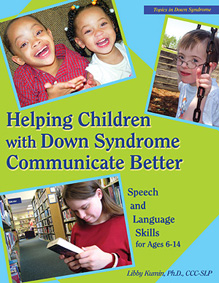Reviews
“As young children with Down Syndrome age, they often come up against speech and language difficulties, especially with peers in school and people outside their family circle. Addressing these challenges in children between the ages of six to fourteen, the author, an expert in communication and Down Syndrome, offers insight into language pragmatics, building conversation skills, using augmented communication systems, and improving intelligibility. This volume covers specific approaches for assessment and evaluation, strategies for home and school settings, and case study material that should prove beneficial to parents and professionals alike.”
- Disability Resources Online
“Dr. Libby Kumin, an expert on Down syndrome and communication, presents Helping Children with Down Syndrome Communicate Better: Speech and Language Skills for Ages 6-14, a guide for both parents and professionals to helping young people develop their speech, language, and communication skills. Chapters discuss the factors that make speech and language difficult, especially for children with Down syndrome; how to assess language and speech treatments; fostering conversational skills; and much more. Black-and-white photographs, anecdotes, home activities for practicing communication skills and more enhance this user-friendly compendium. A ‘must-have’ for educators and parents responsible for a child with Down syndrome, Helping Children with Down Syndrome Communicate Better is also a valuable supplement for anyone teaching communication skills to young people with different types of mental handicaps.”
- The Midwest Book Review
“Dr. Libby Kumin has succeeded once again in preparing a useful resource for families who have a child with Down syndrome and for those professionals most likely to support such a child and family. She facilitates the reader’s understanding of communication, speech and language through the clarity of her explanations of typical development, and her powerful examples of the struggles often experienced by children with Down syndrome — highlighting the importance of providing a meaningful communication system for this population. Her comprehensive description of a communication evaluation — what to expect, how to prepare, the components of the assessment — is masterful as she provides a guide families can follow as they navigate the evaluation process. Dr. Kumin also guides the reader through the complexities of the service system recognising the challenges families may face as they determine ways to access a collaborative team and a credentialed speech-language pathologist who can guide the intervention process, particularly for communication. Kumin considers several options for supporting the communication of children with Down syndrome, identifying those with a scientific evidence-base and those guided by clinical experience. The plethora of activities to support communication at home, school and in the community is impressive. Kumin provides a powerful ending with 10 tips for nurturing the communication of a child with Down syndrome. She recognises the value of family involvement, the influence of culture and the strengths children with Down syndrome bring to their learning.”
- Patricia A. Prelock, PhD., CCC-SLP Professor & Chair, Department of Communication Sciences University of Vermont |



